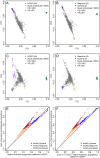Subtypes of Native American ancestry and leading causes of death: Mapuche ancestry-specific associations with gallbladder cancer risk in Chile
- PMID: 28542165
- PMCID: PMC5444600
- DOI: 10.1371/journal.pgen.1006756
Subtypes of Native American ancestry and leading causes of death: Mapuche ancestry-specific associations with gallbladder cancer risk in Chile
Abstract
Latin Americans are highly heterogeneous regarding the type of Native American ancestry. Consideration of specific associations with common diseases may lead to substantial advances in unraveling of disease etiology and disease prevention. Here we investigate possible associations between the type of Native American ancestry and leading causes of death. After an aggregate-data study based on genome-wide genotype data from 1805 admixed Chileans and 639,789 deaths, we validate an identified association with gallbladder cancer relying on individual data from 64 gallbladder cancer patients, with and without a family history, and 170 healthy controls. Native American proportions were markedly underestimated when the two main types of Native American ancestry in Chile, originated from the Mapuche and Aymara indigenous peoples, were combined together. Consideration of the type of Native American ancestry was crucial to identify disease associations. Native American ancestry showed no association with gallbladder cancer mortality (P = 0.26). By contrast, each 1% increase in the Mapuche proportion represented a 3.7% increased mortality risk by gallbladder cancer (95%CI 3.1-4.3%, P = 6×10-27). Individual-data results and extensive sensitivity analyses confirmed the association between Mapuche ancestry and gallbladder cancer. Increasing Mapuche proportions were also associated with an increased mortality due to asthma and, interestingly, with a decreased mortality by diabetes. The mortality due to skin, bladder, larynx, bronchus and lung cancers increased with increasing Aymara proportions. Described methods should be considered in future studies on human population genetics and human health. Complementary individual-based studies are needed to apportion the genetic and non-genetic components of associations identified relying on aggregate-data.
Conflict of interest statement
The authors have declared that no competing interests exist.
Figures




References
-
- Henley SJ, Weir HK, Jim MA, Watson M, Richardson LC. Gallbladder Cancer Incidence and Mortality, United States 1999–2011. Cancer epidemiology, biomarkers & prevention: a publication of the American Association for Cancer Research, cosponsored by the American Society of Preventive Oncology. 2015;24(9):1319–26. 10.1158/1055-9965.EPI-15-0199 . - DOI - PubMed
-
- Pino-Yanes M, Gignoux CR, Galanter JM, Levin AM, Campbell CD, Eng C, et al. Genome-wide association study and admixture mapping reveal new loci associated with total IgE levels in Latinos. The Journal of allergy and clinical immunology. 2015;135(6):1502–10. 10.1016/j.jaci.2014.10.033 ; - DOI - PMC - PubMed
MeSH terms
Grants and funding
LinkOut - more resources
Full Text Sources
Other Literature Sources
Medical
Molecular Biology Databases

